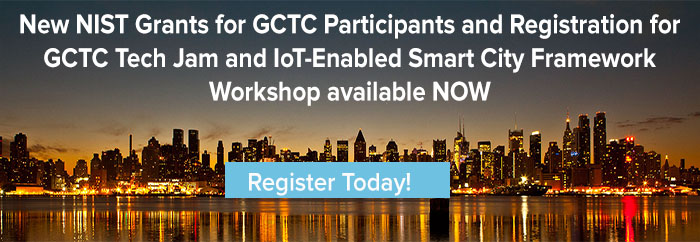The terms denote engineering domains that have high CPS content.
forum
Submitted by Anonymous on Wed, 02/24/2016 - 11:06am

Hello all,
I am writing to bring to your attention that registration is now open for the GCTC Tech Jam, March 22-23, and IoT-Enabled Smart City Framework Workshop, March 24-25. Both events will take place at the NIST Campus in Gaithersburg, MD. There is no cost to participate in the events, but registration is required by March 15, 2016.
forum
Submitted by Anonymous on Mon, 02/22/2016 - 2:56pm
U.S. Transportation Secretary Anthony Foxx announced a Smart City Challenge to create a fully integrated, first-of-its-kind city that uses data, technology and creativity to shape how people and goods move in the future. The winning city will be awarded up to $40 million from the USDOT (funding subject to future appropriations) to implement bold, data-driven ideas by making transportation safer, easier, and more reliable. Additionally, Paul G. Allen's Vulcan Inc., has announced its intent to award up to $10 million to the USDOT winner of the Smart City Challenge.
forum
Submitted by Anonymous on Tue, 02/16/2016 - 2:34pm
video
Submitted by pstone on Mon, 02/15/2016 - 3:03pm
file
Abstract:
The use of robots in society could be expanded by using reinforcement learning (RL) to allow robots to learn and adapt to new situations on-line. RL is a paradigm for learning sequential decision making tasks, usually formulated as a Markov Decision Process (MDP). For an RL algorithm to be practical for robotic control tasks, it must learn in very few samples, while continually taking actions in real-time. In addition, the algorithm must learn efficiently in the face of noise, sensor/actuator delays, and continuous state features.
file
Abstract:
Securing critical networked cyber-physical systems (NCPSs) such as the power grid or transportation systems has emerged as a major national and global priority. The networked nature of such systems renders them vulnerable to a range of attacks both in cyber and physical domains as corroborated by recent threats such as the Stuxnet virus.
file
Abstract:
The goal of this research project is to create a scalable and robust cyber-physical system (CPS) framework for the observation and control of the functional interdependencies between bridge structures (stationary physical systems) and trucks, vehicles and human inspectors (mobile physical agents). Figure 1 shows the SHM-based CPS framework that is built around demonstration highway bridges with permanent wireless bridge monitoring system installed.